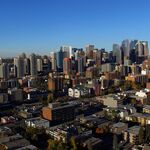I think the challenge is, the main streets are also doubling as the main commuter arterial given the layout of our city. No real alternative to 16th Avenue, unless you go quite a ways north to John Laurie Boulevard/McKnight. The only mainstreet I can think of that doesn't double as a main car connection is 1st Ave in Bridgeland.
Not saying the car should be what the driving design factor is, but it does highlight the challenge. For instance, the plan to drop a lane from 9th Ave SE in Inglewood (I think this is still the plan, but not sure, plannign in Inglewood always seems to be shifting/changing) would severely hamper the travel times for the Max Purple, a bus line we spend $180 million on with the 17th Ave SE and Deerfoot crossing with the entire intent of speeding up the travel times.....
It certainly is a challenge. I see the car-throughput capacity v. local development balance being really a question about what lands should be benefitting - the immediate local development land or the distance car-oriented ones.
With few exceptions, Calgary has typically chosen to benefit the driver and car-throughput over local land activity. Car infrastructure benefits the longer commutes the most, as temporary congestion improvements from road and highway expansions brings outlying areas "closer". Essentially we are discounting local lands to benefit lands far away.
The most obvious part of this trade-off is physical space - road expansion take a lot of it, often where it is higher value due to it's centrality in the overall city. Every bit of land set aside for future expansion and every plot expropriated is a loss of property tax into the future permanently. Even if the land is never needed and it's decided to give it back to development, many remnant parcels set aside for roadway expansion or setbacks become unusable because of the weird shapes, sizes and accesses created from the road expansion. 16 Avenue and most arterials have countless examples of land inefficiently allocated for past or future expansions to the detriment of local development potential.
The second trade-off comes the road operations and planning rules - banning street parking to promote car-throughput is a small but real disadvantage of any business that may choose to set up there. Throw in setback requirements, parking rules, access ramps and circulation requirements - all sized for vehicles - and we've further tipped the scales of what is possible and what isn't on any particular site by adding costs to development and geometric constraints to sites. These start preventing what types of development from occurring and types of businesses from locating there.
Beyond that, the general unpleasantness of wider, louder, dirtier and faster roads indirectly influences the whole process to local detriment. It becomes harder for anyone to imagine repurposing space. Harder for communities or businesses to propose something different. Easier to dream up another road expansion to de-bottleneck the next junction, a project that wouldn't have existed if only we had resisted de-bottlenecking the first.
As an aside - you mentioned one of the weirder quirks of Calgary Transit I noticed about Calgary Transit. CT has often been a supporter of highway and roadway expansion, which is almost unheard of for a transit agency. On the surface, it seems like that might make sense like the Max Purple example or some of the joint LRT/Crowchild/Bow Trail expansion projects where hypothetical synergies exist. But Transit's support of road expansion is a penny wise, pound foolish gamble where they ultimately lose. CT is a chicken cutting a set of keys to the hen house for the fox, in hopes the door might be left open sometimes for their convenience.
Sure preventing traffic calming and on-street patios in Inglewood may speed your buses up temporarily , but you are actively cutting down development potential and attractiveness of the most transit supportive areas. In the long run, supporting car-capacity projects undermines transit altogether - all ground is ceded to marginally increase the value of low, low-density, car-oriented spaces in which transit can't compete. Big picture - it makes no sense for Calgary Transit to support car-orientation of anything, that is their only competitor! Calgary Transit should vocally be opposing all poor land use, be against all highway expansion etc.
In conclusion - cars, parking and arterial roadways are all useful and necessary things. In many areas these should be prioritized. There's always room to tweak then, make them run more efficiently and ensure they are safe (e.g. fiddle with signal timing, avoid weird merges etc.) But for the relatively small area of the inner city where the local development can actually achieve a greater outcome, we need to be far more aggressive in flipping the balance fully in favour of local development over car-throughput.




